4 What Bumble bees Will You Find in Cape Breton?
What do you call a bee that can’t make up their mind? A maybe
To the best of our knowledge, bees have been present on earth since the early cretaceous period which occurred about 130 million years ago. Scientists believe that during a global cooling period, natural selection favoured bees that were able to withstand colder temperatures. And so, a genus of bee that was able to adapt and live in cooler environments evolved over several generations. The Bombus genus consists of both true bumble bees as well as the subgenus Psithyrus which are commonly known as cuckoo bumble bees.
True bumble bee queens emerge from their winter burrows in early spring and they create their own nest and caste of female workers. Cuckoo bees, however, emerge later in spring and summer than their true bumble bee counterparts. At this time, true bumble bees have already established their nests and have hatched a number of worker bees. Cuckoo bees then usurp the true bumble bee queen and steal her nest and caste of worker bees. The cuckoo bee then lays her own eggs and becomes the new queen of the true bumble bee workforce who then raise her young for her.
Today, there are about 250 known species of bumble bee around the world. In this chapter, you will learn how to identify the different bumble bees found in Cape Breton using the skills you have already learned.
Interested in learning about other bumble bees you will find in North America? Bumble bee watch is an excellent online resource for naturalists who are keen to learn more about bumble bee identification. The images below that display characteristic traits of bees are courtesy of their online bumble bee species identification guide.
Yellow-banded bumble bee (Bombus terricola)
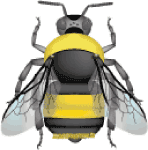
The yellow-banded bumble bee is currently listed as a Species of Special Concern by COSEWIC which stands for the Committee on the Status of Endangered Wildlife in Canada. This means that a group of experts have determined that this species is at risk due to a variety of environmental conditions. You can still find them in Cape Breton, however, it has become increasingly difficult for them to thrive in urban environments. You’re more likely to find yellow-banded bumble bees in wild meadows and other areas that have not been heavily impacted by humans.
How to identify: These bees are easily distinguished from other bumblebees in Cape Breton due to their distinctive yellow black banded pattern. This pattern is unique to Bombus terricola as no other bumblebee has a similar pattern. These bees love fireweed and you’ll often find them foraging on it in July.
Where can you find them: Yellow-banded bumble bees are normally found in rural or wild areas that are not disturbed by the presence of human activity.
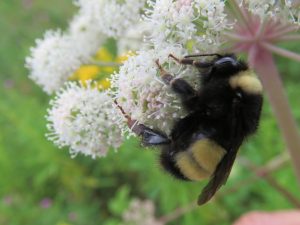
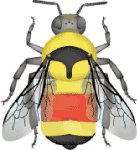
Tri-coloured bumble bee (Bombus ternarius)
Tri-coloured bumble bees are one of the easiest bumble bees to identify. The tri-coloured bumble bee is a very common bee that you can find foraging on many native species of plants as well as non-native plants that you may find in backyard or community gardens.
How to identify: These bees have a mainly yellow thorax with a black downward facing arrow that points towards the abdomen. The abdomen is yellow, then orange, then yellow again.
Where can you find them: Tri-coloured bumble bees are very common and you can find them just about anywhere! You can find these bees in both urban and rural areas as well as in wild areas.
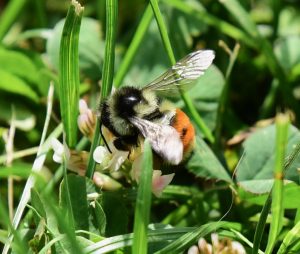
Red-belted bumble bee (Bombus rufocinctus)
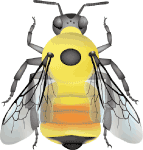
Red-belted bumble bees can vary in appearance. These bees are fairly common and can be found on flowers such as St. John’s Wort.
How to identify: For the most part, these bees have a yellow thorax with a black ovular shape in the center of the thorax. The first two segments on the bumble bee’s abdomen are yellow followed by orange and then black.
Where can you find them: Red-belted bumble bees are common in urban and suburban areas as well as local parks.
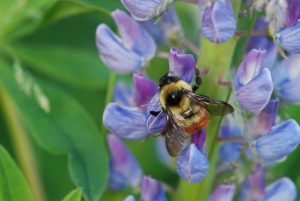
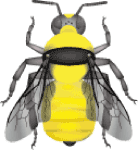
Northern amber bumble bee (Bombus borealis)
The northern amber bumble bee is one of the larger bumble bees that you will find in Cape Breton. These bees are commonly found foraging on New England Aster, tufted vetch, and non-native species such as bee balm.
How to identify: These bees have a yellow face with a black band between their wings. The rest of their body is a yellow amber-ish colour with the exception of the sides of the bee’s body which are black.
Where can you find them: Northern amber bumble bees can be found in urban and suburban environments but also in some rural and wild areas. Generally, you can find these bees around aquatic environments such as lakes, rivers, and oceans.
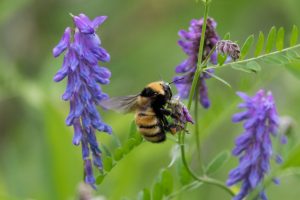
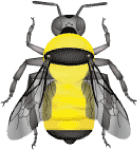
Golden northern bumble bee (Bombus fervidus)
These larger bumble bees look very similar to the Northern amber bumble bee and therefore it is important to pay close attention to the key identification characteristics when trying to identify an individual.
How to identify: The golden northern bumble bee has very dark black wings which stand out against its mainly yellow body. These bees have a black face as well as a stripe of black between their wings and on their last segment of their abdomen. Younger bees can have bright yellow hairs on their bodies whereas older workers will be more pale yellow in colouring. Unlike the northern amber bumble bee, Bombus fervidus has yellow colouring along the side of its body.
Where can you find them: Golden northern bumble bees are normally found in urban and suburban environments
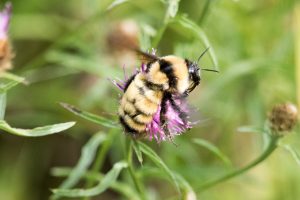
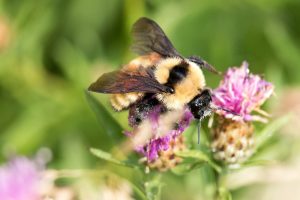
Pyrobombus
Pyrobombus is a subgenus of bumble bee which consists of 43 different species of bees. In some cases, bees in the subgenus Pyrobombus have to be examined under a microscope in order to properly identify them. This can make identifying these bees in the field very challenging, therefore, to prevent the risk of misidentifying these bumble bees, we will focus on the identifying characteristics of the subgenus Pyrobombus as a whole instead of the individual species found in Cape Breton.
For reference, there are four species of bumble bee within the Pyrobombus subgenus in Cape Breton: the common eastern bumble bee (Bombus impatiens), the perplexing bumble bee (Bombus perplexus), the half-backed bumble bee (Bombus vagans) and the two-spotted bumble bee (Bombus bimaculatus).
How to identify: All of these bees are identified by notable characteristics such as a mainly yellow thorax with yellow on the first one to two segments on the abdomen.
| Common eastern bumble bee | Perplexing bumble bee | Half-backed bumble bee | Two-spotted bumble bee |
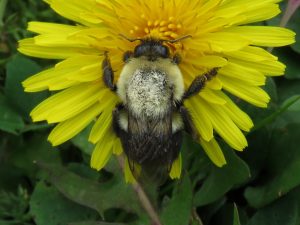 Source: mkkennedy (2019), view page. Source: mkkennedy (2019), view page. |
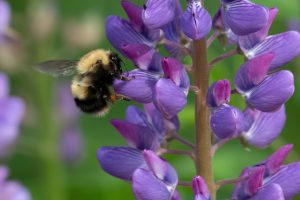 Source: Steven McGrath (2020), view page. Source: Steven McGrath (2020), view page. |
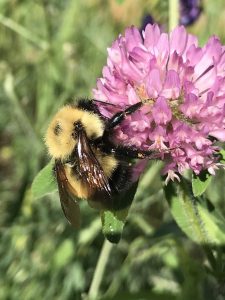 Source: Cody Chapman (2020), view page. Source: Cody Chapman (2020), view page. |
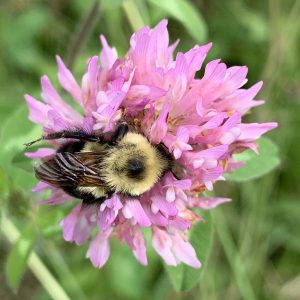 Source: Jeannie Fraser (2020), view page. Source: Jeannie Fraser (2020), view page. |
Fernald’s cuckoo bumble bee (Bombus fernaldae)
The Fernald’s cuckoo bumble bee is a member of the subgenus Psithyrus. As previously mentioned, these bees emerge from their winter burrows later in the season so you’re more likely to see them in summertime as opposed to spring. This cuckoo bumblebee chooses the red-belted bumble bee or the perplexing bumble bee as their host species
How to identify: The Fernald’s cuckoo bumble bee has a yellow thorax with a black ovular shaped marking on the center of the thorax. The first segment of the abdomen is yellow followed by two black segments, then one yellow segment with the end of the abdomen being black. Like all other cuckoo bumble bees, the Fernald’s cuckoo bumble bee does not have pollen baskets.
Where can you find them: Fernald’s cuckoo bumble bees are normally found in wild areas that are not disturbed by human presence.
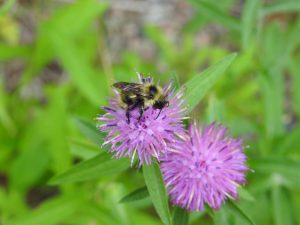
Gypsy cuckoo bumble bee (Bombus bohemicus)
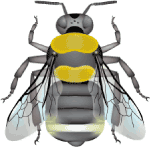
This bumble bee is currently listed as endangered by COSEWIC as it is the cuckoo bumble bee associated with yellow-banded bumble bees. Since their host species is in decline, so is the gypsy cuckoo bumble bee. These bees have not been seen in Cape Breton in about two decades; therefore, if you find one it is very important that you share your findings.
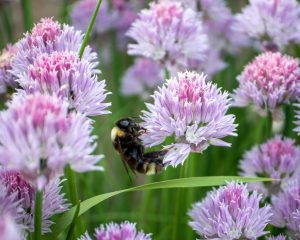
How to identify: The gypsy cuckoo bumble bee has black face colouring with yellow hair colouring on the part of the thorax near the head. This is followed by black hairs then some yellow hairs (usually lighter in colour) leading towards the back of the thorax. The abdomen is mostly black with light white/yellowish hairs on the last few segments of the abdomen. This species lacks pollen baskets on their legs as they do not bring pollen back to the nest. The true worker bees of the host species (in this case the yellow-banded bumble bee) forage for them.
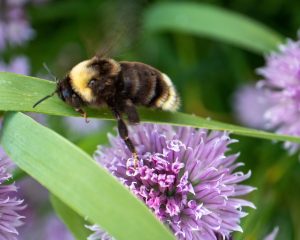
Where can you find them: As previously mentioned, gypsy cuckoo bumble bees are an endangered species and if you find one it would be quite a rare find! If you do want to look around for this at risk bee, rural and wild areas where yellow-banded bumble bees are found would be a good place to start looking.
Source: Wildlife Preservation Canada (2020). View Site.
Let’s put what we have learned thus far to the test. In this matching quiz, can you identify the species of bumble bee in each photo?
A period of time which occurred around 145.5 and 65.5 million years ago when the dinosaurs were still present on earth.
When organisms that are best suited to their environment are more likely to survive than those that are not. Learn more about this concept and the theory of evolution here.
Subgenus Psithyrus. Bumble bees that do not make their own nests. Instead, Psithyrus usurp queen bumble bees and lay their eggs in their nests and allow host workers to rear their young.
The only reproducing bee in a bumble bee colony. This bee overwinters in a burrow and spends the majority of spring building her colony of workers.
A female bumble bee that completes different tasks inside and outside the hive to keep things in tip-top shape. A female descendent of a queen bumble bee.
Committee on the Status of Endangered Wildlife in Canada who are responsible for determining if a species is at risk.
The action of a bumble bee gathering pollen and nectar.
A species that has exists within its natural range and was not introduced to an area by humans.
The part of a bumble bee located just behind its head and right before the abdomen. The wings are attached to this part of a bumble bee.
The part of a bumble bee right after its thorax. Also referred to as the back of the bumble bee.
Different interlocking sections of a bumble bees abdomen often useful when identifying the sex and species of a bumble bee.
A species that has been introduced to an area that is not within its natural range by humans. Can also be referred to as an invasive species in some circumstances.
Different interlocking sections of a bumble bees abdomen often useful when identifying the sex and species of a bumble bee.
The area on the legs of a female bumble bee where pollen is stored.
The part of a bumble bee near the front of its body where its eyes and antennae are located.

